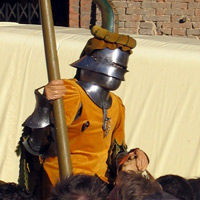The Crusaders
[ Back to other Historical Travellers ]
In the 11th century, the countries of Europe had yet to emerge – the continent was a patchwork of smaller kingdoms, each with their own rulers. By 1095 Islam had spread to the Holy land, encompassing two-thirds of the area.
|
The Crusades were a series of wars between 1095-1400 AD initiated by the Christians to win back the Holy Lands (modern Palistine). It all stared when the Islamic Turks established a capital close to Constantinople, which was a major Christian capital in the east (the Byzantine Empire). The Emperor of Constantinople asked the Pope for help, who responded and decided to try and reclaim all of the Holy Lands too. The Pope called on Christian Knights to stop fighting each other and to ‘take the cross’ and fight the Muslims.
There were many crusades over hundreds of years. The first crusade was very successful, though later ones were not so. The fighting was generally fairly savage and brutal.
|
The Crusaders
The Crusaders were volunteers. At the time it was not called a crusade - it was generally called a pilgrimage. Taking the cross gave certain privileges – they were given the Indulgences – forgiveness of all sins, and their families and assets were protected by the church in their absence.
Though Shalt Not Kill
For Christians, even though it is against one of the 10 commandments, war can be justified. The war must have just cause, it must be authorised by authority, and the participants must have the right intention – they must have pure motives with war being the only practical means of achieving this. To the Crusaders, the crusades were not only justified, but positively sanctioned by God (a Holy War).
Effect on Culture
As a military campaign, the Crusades were generally a failure, however the stories brought back by the crusaders who had left their homes to fight a distant war encouraged their countrymen to look beyond their villages for the first time. Western Europeans became interested in other cultures, and opened their minds to other ideas. There was bringing back of spices, knowledge, ideas and treasures (eg. windmills, carpets, compasses, fruit and spices). All of this lead to exciting advances in technology and the arts – what we now call the Renaissance period.
|
Crusader art
The crusades were held over many centuries and many cultures, therefore art from the period shows a wide range of styles and techniques. Many of the images show interesting use of perspective and a high number of battle scenes. The art from this period can be considered a pictorial record of events, but also propaganda of battle successes.
Do you have feedback, a comment or correction? Let us know



